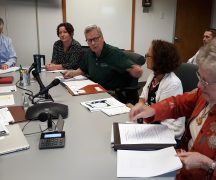By JAN LARSON McLAUGHLIN
BG Independent News
One of the three pipelines crossing through Wood County found a different route – allowing it to transport its product without digging a single new trench through local fields.
Rather than plowing its own route through the county, the Utopia pipeline built by Kinder-Morgan ended up using an under-utilized existing pipeline to pump ethane from the east side of Ohio to Sarnia, Ontario.
“You’re not going to see that,” Allen Fore, Kinder-Morgan public affairs vice president, said recently as he sat in Kermit’s Restaurant and looked outside at the torn up pavement for the Columbia Gas project in downtown Bowling Green.
The $540 million Utopia pipeline, which is capturing the gas being flared away from fracking in southeastern Ohio, has been in operation since January. But before Kinder-Morgan officials found the existing line to use, its route for the Utopia pipeline ran into court battles from Wood County landowners.
Last year, local landowners who dug in their heels against Utopia’s eminent domain efforts won the battle to keep the pipeline from crossing their properties.
Maurice Thompson, of the 1851 Center for Constitutional Law which represented 26 Wood County landowners, said the use of existing pipelines is the best solution.
“That’s what we’ve argued all along,” Thompson said. “Use existing pipelines instead of taking more land.”
The proposed Utopia line would have run 21 miles through Wood County – south of Pemberville, then north of Bowling Green, then crossing the Maumee River south of Waterville. It would have affected 67 landowners on 117 tracts of land.
“Sometimes these things start as adversarial and end in a good way,” Fore said.
Meanwhile, two other new pipelines have been constructed through Wood County in the past year. The Rover pipeline cuts through the southern portion of the county, and the Nexus pipeline runs north of Bowling Green.
The repurposing of a pipeline worked well for Kinder-Morgan and local landowners. The project started with 147 miles of pipeline being constructed from Harrison County to Seneca County. There the new line connected with the repurposed pipeline for 77 miles through Sandusky, Wood and Lucas counties.
“It can work,” Fore said. “This was a real win-win for everyone.”
There are more than 2 million miles of pipelines already buried across the U.S., according to Fore.
“If you can utilize existing infrastructure, there’s a benefit. There’s more certainty,” he said.
By using 77 miles of an existing pipeline, Kinder-Morgan avoided construction headaches, and landowners didn’t have acreage dug up. The environment also benefited, Fore said. The existing pipeline from the Clyde area through Wood County, eliminated the need to cross 103 streams, 16 wetlands, and 42 archaeological and cultural sites.
“It lessened the environmental impact,” he said.
Repurposing old pipeline also means no repaving of roads, and no restoring of land for owners after construction.
The older pipeline was built in the 1970s, and was in good condition, Fore said.
“Pipelines don’t have an expiration limit,” he said, adding that the line was thoroughly tested before Kinder-Morgan bought it. “We did our due diligence before purchasing it to make sure it’s good.”
According to Fore, the use of an existing under-utilized pipeline did not save Kinder-Morgan a great deal of money. An estimated 25 percent of the landowners had already agreed to and received payments for the Utopia pipeline crossing their properties – and were allowed to keep those payments.
Construction of the entire length of the Utopia line did not make use of eminent domain rights, Fore said. Instead, 350 route adjustments were made to satisfy landowners, he added.





